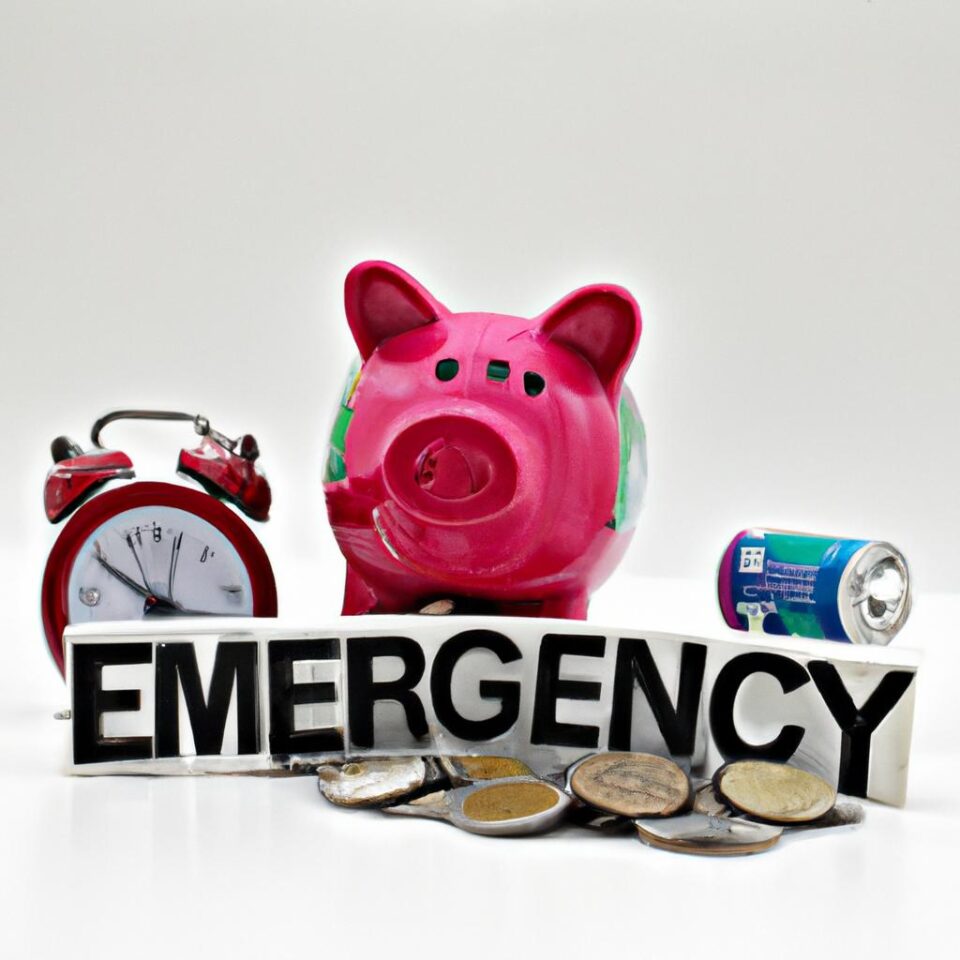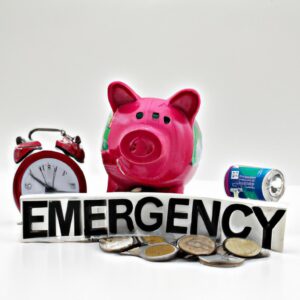Building an Emergency Fund: Why It’s Important and How to Start
Having an emergency fund is a crucial part of planning for the future and maintaining financial security, yet many people do not prioritize saving money for emergencies. An emergency fund can provide peace of mind during times of unexpected expenses, such as an emergency medical bill, job loss, or car repair. Building an emergency fund takes time and effort, but it’s well worth it in the long run to have financial security and stability.
This guide will provide step-by-step instructions on how to build an emergency fund, including understanding your current financial situation, creating a budget, setting up automatic transfers, opening a high-yield savings account, cutting unnecessary expenses, supplementing your income, and investing. Following these steps will help you build a comfortable cushion that will protect you from financial disasters.
Step 1: Assess Your Financial Situation
The first step in building an effective emergency fund is to assess your current financial situation. Take time to review your income and expenses, existing debts, and any savings goals you may already have. This will give you a clear idea of how much money you can realistically set aside each month. It’s also important to determine what your emergency fund goals are and how long it will take you to reach them. By setting realistic goals now, you can stay motivated and on track to achieving them in the future.
Step 2 – Establish a Budget
When it comes to building an emergency fund, having a budget is the first and most important step. An effective budget allows you to accurately assess your current financial situation, identify any opportunities for saving money, and maintain control over your spending. A good budget should include both necessary expenses and savings contributions. It helps if you review your financial records to get a better idea of where your money is currently going.
To start creating an effective budget, list all your monthly income sources, such as salary or other forms of regular payments. Then, write down all the recurring expenses that you must pay each month, such as rent, utilities, food, and insurance. Once you have a clear picture of your income and expenses, you can begin adjusting your budget to make room for regular savings contributions.
Setting Up Automatic Transfers
Setting up automatic transfers from your checking account to your savings account is one of the best ways to start an emergency fund. This makes it easier to build up your savings quickly and it’s a great way to ensure that you are consistently saving a portion of your income each month. Automatic transfers also give you more control over your money by allowing you to decide how much you want to transfer and when.
The benefits of using automatic transfers to build an emergency fund include:
- Helps you build up your savings quickly.
- Allows you to be consistent with your savings goals.
- Provides more control over your money.
- Gives you peace of mind knowing that bills and expenses will be taken care of.
Setting up automatic transfers is easy and can be done online or through your bank. To get started, you’ll need to set up an account with your bank, and then contact them to inquire about automatic transfers. Be sure to ask about any applicable fees and make sure that you understand the terms and conditions.
Step 4 – Open a High-Yield Savings Account
When building an emergency fund, it is important to make sure your money is earning as much interest as possible. A high-yield savings account can provide this and help you reach your savings goals faster. When choosing an account, look for one that offers the highest interest rate as well as no or minimal fees. Additionally, make sure the account is easily accessible so you can get to your money when you need to.
Some popular high-yield savings accounts include online-only banks and credit unions. Online-only banks often have higher yields than traditional banks, and they often have fewer fees which can give you more money in your pocket. Credit unions are also a great option, as they typically have lower fees and higher interest rates than regular banks. Finally, look into checking accounts with an attached savings account. These accounts offer higher interest rates than regular checking accounts and often come with fewer fees.
Step 5 – Cut Unnecessary Expenses
Having an emergency fund doesn’t just happen overnight. To accumulate money for either short or long-term plans, you need to take a hard look at where your money is going. It’s important to identify common areas where you can cut spending and save more money.
Some typical examples include:
- Eliminating expensive meals out
- Reducing clothing, entertainment, and leisure costs
- Canceling unnecessary subscriptions or services
- Avoiding impulse purchases
- Cutting down on excessive utility and energy costs
Take the time to review your expenses and make sure that every dollar is necessary. Every penny counts should you ever need your emergency fund in the future.
Step 6 – Supplement Your Income
Everyone has a different financial situation, but most people have room to increase their income if they put some effort into it. A great way to supplement your income and build an emergency fund is by looking for additional work or starting a side hustle.
Some popular side hustles include freelancing, driving for ride-sharing services, or offering services such as house cleaning or pet sitting. You could also look for freelance writing or editing gigs online. Start exploring ways to make additional money today, and you may be surprised how quickly you can build up your savings.
Building Up Your Fund Slowly
Saving for an emergency fund does not always have to be a daunting task. In fact, with a bit of planning and strategy, building up an emergency fund can be done gradually over time. To do so, you should start by setting up automatic transfers from your checking account to your savings account once paycheck is deposited. This makes it easier to save without having to manually transfer funds each time.
Additionally, cutting out unnecessary expenses can also help you save more. Identify areas of spending that are non-essential and take the necessary steps to reduce or eliminate those expenses. This could include things like dining out, subscriptions you don’t use, and other impulse purchases. When combined with automatic transfers, this will help contribute more to your emergency fund.
If you have the ability to earn more money, you might also want to consider supplementing your income. You could explore additional employment opportunities, such as freelancing or taking on part-time work. Or you could start a side hustle through selling goods online or providing services for a fee. All of these options not only give you the opportunity to increase your income, but to put more money towards your emergency fund as well.
Step 8 – Start Investing
Investing is one of the best ways to help build wealth over time and create a solid financial foundation for the future. With an emergency fund, you can start investing with a smaller amount and still make money with minimal risk.
Although there is no one-size-fits-all solution for investing, there are some basic strategies to consider that can help your money grow:
- Set aside a portion of your income specifically for investing.
- Look into different types of investments, such as stocks, bonds, mutual funds, or exchange-traded funds.
- Create a diversified portfolio with a mix of investments to minimize risk.
- Research fees associated with each type of investment.
- Consult with a financial planner or advisor if necessary.
Investing can be intimidating at first, but it doesn’t have to be. With the right guidance and research, anyone can begin to build wealth over time through smart and strategic investments.
Step 9 – Emergency Situations
When it comes to emergency situations, it’s important to be prepared. Life can throw a lot of unexpected events our way, so it’s essential to be prepared financially as well. Have a plan in place for any type of emergency situation that may arise. Make sure to set a budget and keep track of it, as this will help you stay on top of your expenses. Set aside money in your emergency fund for any unplanned costs in life, such as medical bills or home repairs. Be aware of your insurance policies and if they cover any unexpected costs. It is also recommended to keep some cash stashed away in case of an emergency.
Know what to do in the event of a natural disaster like a hurricane, tornado, or earthquake. Have an emergency plan in place with the supplies, food, and water necessary in the event of such a situation. In addition, if you have a credit card, ensure you have enough funds to cover your expenses in case of an emergency.
For those living paycheck to paycheck, it is important to build a financial cushion that will act as a buffer during these difficult times. Building an emergency fund will help decrease stress and provide peace of mind in times of uncertainty.
Step 10 – Reassessment: Tracking Your Progress
Now that you’ve created your emergency fund, it’s important to stay on track and check in occasionally to make sure it’s growing as planned. Take this opportunity to review your budget, goals, and spending habits, and adjust if needed.
You should also take a look at interest rates for your savings accounts and investment options. Monitor the potential high-yield savings accounts you selected to ensure you’re getting the most out of your emergency fund.
It’s also important to reassess your emergency fund if there are changes in your financial situation. For example, if you experience changes in income, or unexpected expenses, you may need to adjust how much you’re contributing to your fund each month.
By tracking your progress and making adjustments when necessary, you can ensure that your emergency fund continues to grow and thrive. There’s no set timeline for how often you should reevaluate – just remember to take stock of your situation every few months or so.
Conclusion: Building an Effective Emergency Fund
Having an emergency fund is an essential part of a secure financial plan. It gives you a cushion to fall back on in the event of an unexpected or emergency expense, helping to avoid high-interest debt and costly fees. Building an emergency fund is not difficult, but it takes some time and effort. Once you have assessed your current financial situation, established a budget, set up automatic transfers, opened a high-yield savings account, and cut unnecessary expenses, you are well on your way to building an emergency fund.
Supplementing your income by taking on additional work can help accelerate the process. Although it may take some time to build up the fund, it’s important to make slow, steady progress. As you start to save more money, consider investing in order to grow your wealth. Finally, it’s important to constantly reassess your emergency fund and adjust your strategies as needed.
Building an emergency fund is a crucial step towards financial success. Taking the time to prepare now will help protect you in the future. With these tips and strategies, you’ll be well on your way to having a healthy and secure emergency fund.
comments: 0

